Spreading the Word About Blurbs
Are blurbs more effective in brick-and-mortar stores where prospective readers could pick up the book off a shelf and read the blurbs on the back cover or on one of the inside front pages? Or are they stronger on websites with catchy phrases to lure in potential readers?
In other words, do they help readers find out what the book is about and generate sales?
There are basically two types of blurbs. One is generated by the author or publishing house and generally found on the back cover. Other blurbs are solicited by authors or publishing houses for use in an author’s book. But there are exceptions.
Gelett Burgess, an American humorist, author, and artist, coined the word in 1907, defining it as “a flamboyant advertisement; an inspired testimonial.” He used it in the promotion of his book, “Are You a Bromide?”
All of my novels have blurbs, written by me. Several include additional blurbs from others who read the advanced reader copy, and I’ve written blurbs on books for authors. I’ve read blurbs on digital and traditional books. And I’ve ignored some blurbs because they are basically sales pitches and generally over the top in praise. Not that there’s anything wrong with that but most of us know the primary reasons they’re used—to attract attention and increase sales.
When I write blurbs or ask for them, I prefer those that capture the essence of the novel in two or three sentences. If the blurbist (is that a word?) can do that, then there’s no reason for any hyperbole. Believe me, it’s difficult to do that in a few sentences.
But what do others say about blurbs?
The blogger Charvi maintains in a post that blurbs “can seriously make or break your book.” She believes they give readers some knowledge about the book’s genre; provide readers with an idea of what they’re reading; and give a hint as to the writing style (of course, that depends on the author’s blurb).
A post on Busybird says the blurb “defines what the book is about in 200 words” and that it creates mystery but “mystery can’t give the story away.” In other words, arouse the reader’s interest to read the book.
Besides writing a good book worthy of readers, it takes a strong blurb and eye-catching cover art as well as word-of-mouth recommendations to gain a degree of attention in a packed and growing marketplace that had more than 750,000 books published in 2020.
I suppose I should add one more element to a book’s success: luck.
Until the next time . . .

























